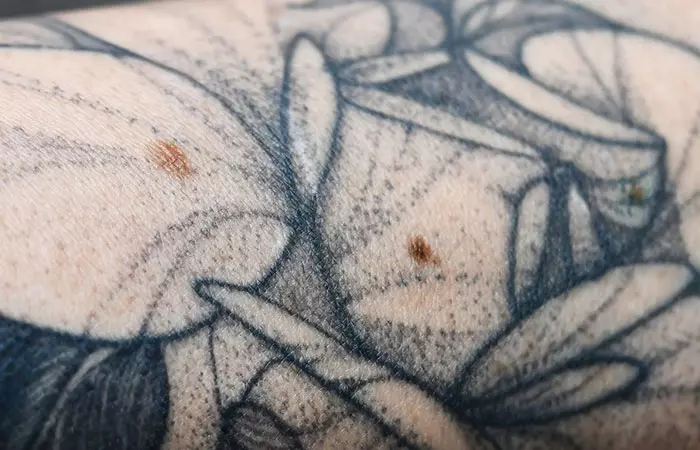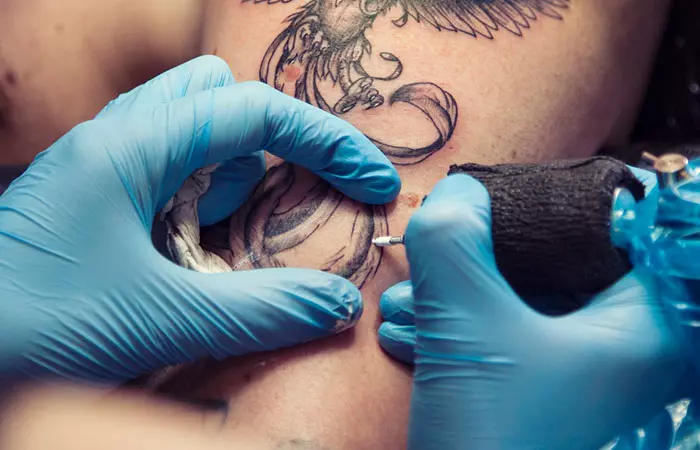Tattoo Over A Mole: Expert Tips For Safe And Stylish Ink
Discover some easy tips and the risks involved in inking over that stubborn mole.

Image: Shutterstock
You have been dreaming about getting your favorite design inked for months. However, that annoying brown growth on your skin has probably got you wondering can you tattoo over a mole or not. Moles, also known as nevi, are raised or flat growths caused by clusters of pigmented cells. While many consider moles to be beauty marks, others may not like them and would like to get a tattoo over them to change their appearance. So, what should you do? How do you go about this? Fret not. Delve into this article to learn if it is safe to tattoo over a mole, some important points to keep in mind, and more. Scroll down to know more!

In This Article
Is It Safe To Tattoo Over Moles?

Most moles are benign but in rare cases, some may be indicative of skin cancer (1). Hence, many specialists may recommend not tattooing over the moles. This is because the ink may mask any changes in size or color during a check-up. On the flip side, old or flat moles that have not changed in size or color may be safe to tattoo over. So, tattooing over moles on the skin should generally be safe, but for the safety of your skin, it is best to discuss it with a medical expert. They might be able to come up with a solution that allows you to get inked over a mole with minimal tattoo side effects.
Apart from your dermatologist, there are several reasons why your tattoo artist may not tattoo over your mole. Find out more in the next section.
Key Takeaways
- Tattooing over moles may hinder the doctor’s ability to catch any size or color changes in moles.
- Tattoo artists may not be willing to tattoo over moles due to potential health risks, aesthetic challenges, and legal restrictions in certain states.
- It is important to consult your dermatologist and get regular check-ups done for early detection of skin conditions before getting a tattoo.
Why Your Tattoo Artist Will Not Tattoo Over Your Mole

- Health Risks
Changes in the shape, pigment, size, edge, form, or texture of moles could be indicators of skin cancer development. Tattooing over them may hinder the doctor’s ability to detect potential health issues early. Hence, tattoo artists may not be open to tattooing over abnormal or benign moles.
- Aesthetic Challenges
Acquiring the correct shade when tattooing over a mole can be challenging due to its unique texture and ability to absorb ink quicker than usual. This may result in an excessively colored effect, impacting the overall aesthetic of the tattoo. Factors like skin structure, genetics, and ink options can influence the outcome. This makes it essential to consider individual skin variations, especially for multicolored tattoos.
 Quick Tip
Quick Tip- Legal Restrictions
Some states and regions in the United States have specific laws against tattooing over moles and certain skin problems as they may cause lesions, scar tissues, or other skin issues. This may force your tattoo artist to turn you away at the door.
If your dermatologist gives you the thumbs up, you can get a tattoo over your mole. However, it is important to keep some points in mind before doing so. Scroll down to know more.
What You Need To Know Before Getting A Tattoo Over Your Mole
Tattooing over your moles is a big move. Hence, keep the following points in mind before doing it:
- Monitor Your Moles

Before tattooing over relatively large moles that have developed in the past 5 years, seek approval from a qualified dermatologist. Regular monitoring and dermatological evaluations will ensure that signs of skin cancer are detected early. Your doctor may even suggest surgical mole removal before going for a tattoo.
- Understand Your Moles
Moles that developed during puberty without significant changes are typically considered safe for tattooing. While most moles are harmless, it is essential to be extra cautious with those emerging in adulthood. Hence, get regular mole checks to look out for significant developments or changes in appearance.
- Consult An Expert
It is best to consult a skilled tattoo artist if you want to integrate your moles into your tattoo designs with darker areas of pigment. This will ensure aesthetic integration without compromising your safety.
If you want to tattoo over your old moles, it is important to know the potential risks associated with it. Find out more in the next section.
Are There Risks Associated With Tattooing Over Moles?
Here are a few risks associated with tattooing over moles:
- May Hinder Skin Cancer Detection
Leaving moles visible allows for easier monitoring, which is crucial for detecting and addressing forms of skin cancer early. Tattooing over a mole, especially those with a history of skin cancer or melanoma, may impede doctors from examining the area in case of a cancer recurrence. Regular checks for the risk of skin cancer and changes in skin cells are essential.
- May Cause Excessive Bleeding
Puncturing the moles with a needle during the tattoo session may cause more bleeding than usual.This may make the process more challenging and potentially lead to complications. Also, the controllable amount of blood typically associated with tattoos may not hold true for moles.
 Quick Tip
Quick TipWhile the desire for body art is understandable, individuals contemplating tattoos over moles should consult both medical professionals and experienced tattoo artists to make informed and safe decisions about their creative expressions.
The decision to get your dream tattoo over a mole involves a nuanced consideration of health, aesthetics, and legal aspects. While tattooing over old moles may be allowed, it is crucial to acknowledge that it may increase the risk of bleeding. Plus, it may hinder a doctor from spotting early signs of skin cancer. Hence, seek dermatological approval for recent moles and consult experienced tattoo artists before getting inked. Remember, the collaborative effort between individuals, healthcare professionals, and tattoo artists play a vital role in achieving a harmonious blend of self-expression and well-being.
Frequently Asked Questions
Should I inform my tattoo artist about my moles?
Yes, it is important to inform your tattoo artist about your moles before getting a tattoo. They can work around them to ensure your safety without disrupting the aesthetics of your tattoo.
Can tattooing cause moles to become cancerous?
No, there is no evidence suggesting that tattooing causes moles to become cancerous. The process involves depositing ink in the outer layers of skin, while moles originate in the deeper layers. It is recommended that you talk to your healthcare provider before getting a tattoo.
Are there certain types of moles that are safer to tattoo over?
Generally, moles that have not undergone significant changes are safer to tattoo over. It is vital to avoid moles showing signs of irregularities. But if you are not sure about it, consult your doctor for further information.
Can I get a tattoo near a mole instead of directly over it?
Yes, you can get a tattoo near a mole rather than directly over it for safety. It is recommended to keep about a 1-millimeter distance between the ink and the spot. This will allow doctors to catch any changes in the mole’s size or color.
Illustration: Can You Tattoo Over A Mole? Possible Risks

Image: Stable Diffusion/StyleCraze Design Team
Tattooing over moles requires careful consideration. Check out this informative video for the potential dangers of inking over those brown growths to help you make an informed choice.
References
Articles on StyleCraze are backed by verified information from peer-reviewed and academic research papers, reputed organizations, research institutions, and medical associations to ensure accuracy and relevance. Read our editorial policy to learn more.
- Melanocytic Nevi
https://www.ncbi.nlm.nih.gov/books/NBK470451/
Read full bio of Ali Aman
Read full bio of Manjari Uppal
Read full bio of Eshna Das
Read full bio of Joyce Joyson


























Community Experiences
Join the conversation and become a part of our empowering community! Share your stories, experiences, and insights to connect with other beauty, lifestyle, and health enthusiasts.